Palandu
|
Botanical Name |
Allium Cepa |
|
Family |
Liliaceae |
|
Sanskrit |
Palandu |
|
English |
Onion |
|
Hindi |
Pyas |
|
Kannada |
Erulli |
|
Malayalam |
Savala |
|
Telugu |
Ullipaya |
|
Tamil |
Vengayam |
|
Marathi |
– |
Distribution
It Is Cultivated All Over India
|
Parts Used |
Bulb, Seeds |
|
Dose |
Choorna 1-3g, Juice 10-20ml |
Chemical Constituents
Cycloallin, quercetin, oleanolic acid
Ayurvedic Properties
|
Quality (Guna) |
Guru, Snigdha, Tiksna |
|
Taste (Rasa) |
Madhura, Katu |
|
Metabolism (Vipaka) |
Madhura |
|
Potency (Virya) |
Anusna |
|
Impact (Prabhava) |
Vatahara |
Pharmacological Action
- Vrsya
- Rasayana
Therapeutic Uses
For swelling and inflammations: the juice of onion and mustard oil is mixed together in equal quantities and applied to the affected part
for epistaxis: juice of palandu should be instilled in to the nostrils (3-4 drops)
for cholera: juice of palandu taken in the dose of 80 ml eradicates cholera
for abscess: prepare poultice using roasted onions, turmeric and ghee mixed together and applied warm, promotes suppuration in an abscess
Some of the common formulations
Palandu swarasa




